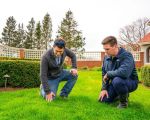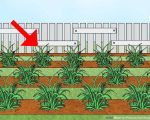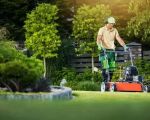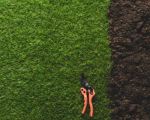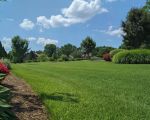
Overseeding Your Lawn in Fall: The Secret to a Healthier, Greener Yard
As the crisp fall air sets in and the days shorten, many homeowners start to think about preparing their lawns for the winter. But did you know that fall is actually the best time to overseed your lawn? Overseeding is one of the most effective ways to maintain a lush, healthy lawn that will thrive in the spring. In this article, I’ll share some of the most valuable tips I’ve learned over the years about overseeding your lawn in the fall, helping you achieve a vibrant, green yard come next season.
1. Why Fall is the Best Time to Overseed Your Lawn
If you’ve ever wondered when the best time is to overseed your lawn, the answer is clear—fall. During the fall months, temperatures are cooler, and there’s usually more rainfall, providing the perfect environment for grass seed to germinate. Additionally, your lawn is not as stressed out by the summer heat, giving new grass seed a better chance to establish strong roots before winter arrives.
In my own experience, overseeding in the fall has worked wonders for my lawn. The soil is still warm enough for the seeds to take root, but the cooler air and increased moisture help them grow more vigorously than in the hot summer months. Plus, fall overseeding helps prevent weeds from taking hold, giving your lawn the upper hand as it enters the winter months.
2. Choosing the Right Grass Seed
Before you start throwing seed onto your lawn, it’s essential to choose the right type of grass. Not all grass varieties are suited for fall overseeding, so selecting the appropriate seed is critical for long-term success. The type of grass you select depends on your region and the climate in which you live. For example, cool-season grasses like Kentucky Bluegrass, Ryegrass, and Fescue perform exceptionally well in northern states where the weather is cooler. If you're in the southern parts of the U.S., you may want to consider overseeding with warm-season grasses like Bermuda or Zoysia. Researching which grass works best for your area can make all the difference in achieving a healthy lawn.
3. Preparing Your Lawn for Overseeding
Before overseeding, the first step is preparing your lawn to ensure that the seeds have the best possible environment to thrive. This preparation begins with mowing your grass. Start by mowing your lawn lower than usual to create a thin layer of existing grass and thatch, allowing the seed to come in contact with the soil more easily. It’s important not to scalp the grass—just trim it to a height that exposes the soil but doesn’t cause damage to your existing lawn.
Next, you’ll want to aerate the soil. Aeration involves creating small holes in the lawn, allowing the seed to penetrate deeper into the ground. This is especially important if your lawn has compacted soil, which is common in high-traffic areas. Using a lawn aerator, you can rent or purchase, will help ensure that water and nutrients can reach the grassroots, promoting healthy growth.
4. Applying the Seed and Watering
Once your lawn is prepped and aerated, it’s time to apply the seed. I’ve found that using a broadcast spreader works best for an even distribution of seed. You’ll want to apply the seed evenly across the entire lawn, ensuring that it is not too thick or too thin. Over-seeding can lead to competition for space and nutrients, while under-seeding will leave areas exposed to weeds.
After spreading the seed, the next crucial step is watering. It’s vital to keep the soil consistently moist, especially in the first few weeks after overseeding. Water the lawn lightly every day or every other day, depending on the weather, to encourage germination. You don’t want to overwater and flood the seeds, but consistent moisture is key to getting your new grass to establish itself.
5. Taking Care of Your Lawn Post-Overseeding
After you’ve overseeded, your job is far from over. You’ll need to continue caring for your lawn as the new grass begins to grow. Keep watering regularly, but gradually reduce the frequency as the grass matures. In addition to watering, I recommend applying a light fertilizer that is specifically designed for newly seeded lawns. This will provide the necessary nutrients to support strong growth and root development.
As the weeks go by and your new grass starts to grow, it’s important not to mow too soon. Allow the grass to reach a height of at least 3 inches before mowing, and make sure your mower blade is sharp to avoid damaging the new growth. Once your new grass is established, it will help crowd out weeds and create a thick, healthy lawn that will look fantastic year-round.
6. Common Mistakes to Avoid When Overseeding
In my years of experience, I’ve seen many people make the same common mistakes when overseeding. To help you avoid these pitfalls, here are some things to watch out for:
- Overseeding too late in the fall: It’s important to get your overseeding done before the first frost hits. If you wait too long, the seeds won’t have enough time to germinate and establish roots.
- Not choosing the right grass seed: As mentioned earlier, selecting the appropriate type of grass for your region is critical. Always make sure you’re using grass suited for your climate.
- Not watering enough: Watering is key in the early stages after overseeding. Don’t let the soil dry out, as this can prevent the seeds from germinating.
By avoiding these mistakes, you’ll give your lawn the best chance of thriving and looking beautiful year-round.
7. Enjoy Your Beautiful Lawn
Overseeding your lawn in the fall is a rewarding process that can result in a lush, green yard come spring. By following these tips, you’ll create a healthier lawn that’s better equipped to withstand the harsh winter months and look fantastic when warmer weather returns. Just remember to give your lawn the care it deserves, and you’ll be enjoying a beautiful yard all year long.
If you’re looking for professional assistance or have questions about lawn care, I recommend checking out our Lawn Care Services. We offer expert advice and hands-on help to ensure your lawn gets the attention it needs to thrive!


